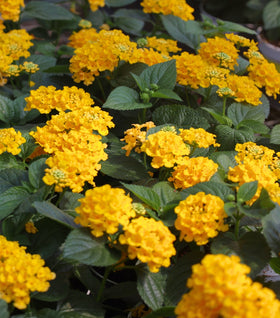Annual Lantanas for Sale Online
Lantana plants are most often used as annual plants with a vining growth pattern. However, these plants are not vining plants; they are shrubs. They are beautiful plants in hanging baskets where their branches can spill over the sides. These colorful annual plants are also known for their clusters of small, vibrant flowers that come in colors such as orange, red, purple, yellow, etc. They thrive best in full sun, well-draining, moist soil conditions.
Oddly enough, most people do not enjoy the fragrance of Lantana flowers, but the aroma of their foliage definitely qualifies them as fragrant plants. Lantanas are pollinator-friendly plants and attract bees, butterflies, hummingbirds, and many other pollinators. They are susceptible to a few diseases, such as Sooty mold and powdery mildew, but these can be avoided with the proper care and attention these plants deserve.
Types of Lantanas Offered At Garden Goods Direct
Bandana Cherry Sunrise Lantana
Blooms cluster-shaped flowers bloom in a variety of colors such as orange, pink, red, yellow, and white. Their multi-colored flowers give them a tie-dye appearance making them the perfect pop-of-color plant for any garden.
Bandana Red Lantana:
Flowers blossom as a dark yellow color and fade into a deep orange as the growing season progresses and finish off as a deep, chocolatey-red color. They are beautiful to plant as container plants on a patio for a beautiful tropical oasis feel.
Bandana Yellow Lantana:
Bandana Yellow Lantanas produce beautiful and bright yellow flowers complemented by their deep green foliage. Their bright and cheery colors make them stunning hanging basket annuals. They can be given as a gift or purchased and enjoyed in any landscape.
How to Care for Annual Lantanas
Water
Lantanas thrive in moist, well-draining soil conditions. These annuals are slightly drought-resistant, but only once they are well established. To help establish your plant, we recommend watering your plant on a daily or weekly basis, depending on your hardiness zone. Once your plant is well-established, don't let its soil dry out. Overwatering can cause root rot disease and damage your plant. The best rule of thumb is to check about 1 inch down in the soil; if it is dry, it is time to water your Lantana.
Soil
These annuals thrive in well-draining, balanced soil. They have no particularity to soil pH and are fairly tolerant to soil salt levels. When planted in your garden, make sure they are in a spot with sandy, well-draining soil conditions. Even though these plants love moist soil, too much water will cause their roots to rot. If your Lantana is potted, use a container with excellent drainage holes to ensure all excess water drains out each time your plant receives water.
Light
Lantana plants prefer to be planted or placed in full sun environments. We recommend giving your plant at least 6 hours of full sunlight each day, preferably more. These annuals can handle a few hours of partial sun a day but need to be kept in full sunlight most of the time. If you keep your plant indoors, place it near a window that gets full but diluted sunlight. Don't forget to turn your indoor Lantana every so often to prevent its leaves or flowers from burning.
Fertilizer
These annuals need fertilizer as soon as they are transplanted. After they are initially transplanted, feed them every 3 to 4 weeks until well-established. The best time to begin fertilizing your established plants is in early spring using a dry fertilizer. Any good quality, well-balanced fertilizer works great. If your Lantana is in a container, you will need to feed it more frequently. Use a slow-release fertilizer in the spring and then supplement with a water-soluble, balanced fertilizer every 2 to 4 weeks.
Common Problems With Lantana Plants
Powdery Mildew
Powdery mildew can become a problem if your Lantana is not given enough light. It will appear on your plant's foliage, looking like white or gray powder that will coat the surface. If left untreated, it can cause your plant's leaves to turn yellow or brown. To get rid of any powdery mildew, you can prune back any diseased foliage. However, if it is more severe, you may have to use a fungicide to get the job done effectively.
Sooty Mold
Sooty mold is a condition that causes black discoloration on your plant's leaves and is most often attributed to whitefly pests. Sooty mold grows in the honeydew, and if pests have gotten into one that has this mold, they can bring it onto your plant, and then it will spread. The best way to treat this problem is to get rid of pests on your plants. You can spray them off with water first, and if this does not work, use a pesticide that is not too harsh. Harsh pesticides could harm pollinators, the good insects around your garden.
Buy Lantanas Online From The Plant Experts
Lantanas are show-stopping, vibrant flowering annuals that light up gardens each year. With many varieties to choose from, you can easily find one that will match the size and style of your garden. As America's number one online plant nursery, our goal is to provide our customers with the highest quality plants available. Each plant we sell gets Woodie's seal of approval so that you can feel confident ordering plants that are healthy and ready to thrive in their new environment. Don't wait, buy Annual Lantanas online today!


